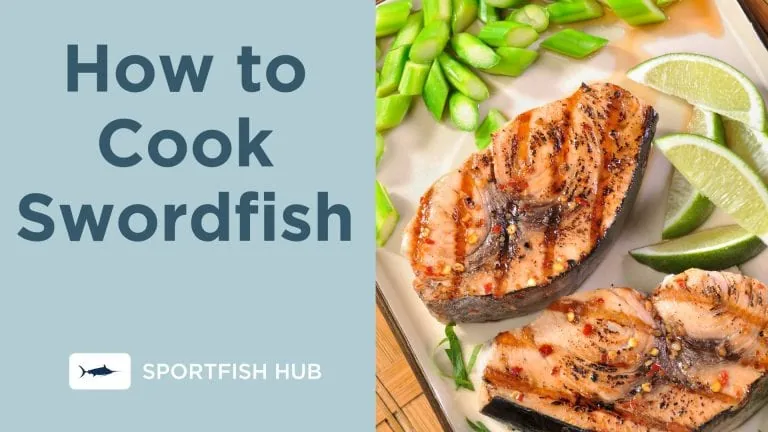Swordfish is a hearty, flavorful fish that can be prepared in many delicious ways. Follow this simple guide to learn how to cook moist, tender swordfish fillets right at home.
- How To Cook Swordfish Video
- Choose High-Quality Swordfish
- How Much Is Swordfish Per Pound
- Prep the Swordfish Properly
- Recommended Cooking Times
- Brush Both Sides with Oil
- Season the Fish Generously
- Sear at High Heat
- Finish in the Oven
- Try Different Cooking Methods
- Pros and Cons of Various Swordfish Cooking Methods
- Pairings for Swordfish
- Allow Swordfish to Rest
- Swordfish Recipe Inspiration
- Sample Swordfish Recipe
- FAQ
- Can I cook frozen swordfish?
- What is the minimum internal temperature for cooked swordfish?
- How long does cooked swordfish last in the fridge?
- Can you cook swordfish on a cedar plank?
- Can you cook swordfish on a panini press?
How To Cook Swordfish Video
Choose High-Quality Swordfish
Always start with fresh, sushi-grade swordfish. Look for thick, firm fillets without any discoloration. Swordfish is a lean fish, so excess moisture on the surface or mushy texture indicates the fish is past its prime.
For best results, use swordfish within a day or two of purchasing. When buying swordfish, look for these signs of freshness:
- Bright, shiny flesh
- Firm, meaty texture
- Clean sea smell
- Clear eyes
- Vibrant pink gills
| Size | Description |
|---|---|
| Small | < 2 lbs |
| Medium | 2-4 lbs |
| Large | > 4 lbs |
How Much Is Swordfish Per Pound
The cost of fresh swordfish varies depending on the time of year and where you buy it. At a local fish market, expect to pay $11 to $30 per pound.
For example, Randy’s Paradise Shrimp in Florida sells fresh swordfish steaks for around $26 per pound. In California, Anderson Seafoods charges almost $32 for 12 ounces of fresh fillet. Frozen swordfish steaks on Amazon go for about $13 per 4-ounce steak.
Prices fluctuate, so check with your local supplier or retailer for current rates.
Prep the Swordfish Properly
Rinse swordfish under cold water and pat dry with paper towels. Trim off any inedible brown parts or bones using a sharp knife.
Cut the fillet into individual serving-size portions, about 4-6 oz each. This ensures even cooking. You can also ask your fishmonger to portion the swordfish for you.
You might also enjoy reading: How to Grill Swordfish to Sweet, Smoky Perfection.
Recommended Cooking Times
| Thickness | Sear Time Per Side | Bake Time in Oven |
|---|---|---|
| 1 inch | 2-3 minutes | 5-6 minutes |
| 1.5 inches | 3-4 minutes | 6-8 minutes |
| 2 inches | 4-5 minutes | 8-10 minutes |
Brush Both Sides with Oil
Coat both sides of the swordfish with a thin layer of high-heat cooking oil using a pastry brush or your fingers. Good oil choices include:
- Avocado
- Grapeseed
- Refined coconut
- Olive
- Vegetable
The oil helps the fish develop a deliciously crisp exterior while keeping it moist inside.
Season the Fish Generously
Swordfish pairs well with bold seasonings. Coat both sides with:
- Sea salt
- Cracked black pepper
- Dried herbs like thyme, rosemary or dill
Other flavorful options:
- Smoked paprika
- Chili powder
- Lemon pepper
- Garlic powder
- Cayenne
Get creative with spice rubs or marinades. A citrus-herb marinade works nicely.
Sear at High Heat
Heat 1 tsp oil in a cast iron or nonstick skillet over high heat until shimmering. Carefully lay the swordfish portions in the pan and cook without moving for 2-3 minutes. This allows the bottom to caramelize.
Flip the fillets and sear another 2-3 minutes until opaque and cooked through. Adjust heat as needed to prevent burning.
Finish in the Oven
For thicker fillets over 1 inch, transfer the pan to a 400°F oven after searing both sides. Bake for 5-8 minutes until the internal temperature reaches 145°F.
The fish will finish cooking gently in the oven without overdrying the exterior. Use an instant-read thermometer to check doneness.
Try Different Cooking Methods
Besides pan-searing, swordfish adapts well to methods like:
- Grilling
- Broiling
- Baking
- Poaching
- Steaming
It also holds up in one-pan dishes, tacos, kebabs and skewers. Experiment with creative recipes and techniques to keep it exciting.
Pros and Cons of Various Swordfish Cooking Methods
Swordfish is a versatile fish and there are multiple methods for cooking it you could utilize. Each technique has its own benefits and downsides. When deciding how to cook swordfish, consider factors like the thickness of the fillets, desired flavors, time constraints, and equipment available. Below is a comparison of some popular cooking methods for swordfish, along with the pros and cons of each.
Pan-Searing
Pros:
- Quick and easy weeknight cooking
- Cooks the fish evenly
- Great for thinner fillets
- It creates a nice golden-brown crust
Cons:
- Lacks smoky grill flavor
- Only browns one side of the fish
Grilling
Pros:
- It adds great char and a smoky flavor
- Ideal for thicker swordfish steaks
- Makes the fish look attractive
Cons:
- Less even cooking compared to pan
- Risk of drying out the fish
- Harder to grill thin fillets
Baking
Pros:
- Very easy hands-off cooking
- Great way to cook fish for a crowd
- Helps keep fish uniformly moist
Cons:
- The surface won’t brown as nicely
- Hard to add grill marks or char
Broiling
Pros:
- Quick and intense heat from above
- Can add char while avoiding grill
- Simple to broil fillets in the oven
Cons:
- Potential to burn or dry out fish
- Hard to broil thicker cuts
- Doesn’t add a smoky flavor
Steaming
Pros:
- Healthy cooking method
- Preserves nutrients and moisture
- Easy and hands-off
Cons:
- Fish can taste bland
- No searing or charring
- Not ideal for thick steaks
Pairings for Swordfish
| Food | Why it Works |
|---|---|
| Lemon | Bright acidity cuts richness |
| Dill | Herbaceous flavor complements fish |
| Asparagus | Elegant vegetable pairing |
| Tomatoes | The herbaceous flavor complements fish |
| Rice pilaf | Absorbs juices and flavors |
| Garlic | Adds depth, antioxidant benefits |
| Olive oil | Healthy fat enhances fish’s richness |
Allow Swordfish to Rest
Let the cooked swordfish rest for 5 minutes before serving. This allows juices to redistribute so the flesh remains hot, moist and tender when you slice into it.
Dig in and enjoy your restaurant-quality seafood meal. Swordfish also tastes amazing when served cold in salads and sandwiches the next day.
Swordfish Recipe Inspiration
| Dish | Ingredients |
|---|---|
| Tacos | Corn tortillas, pico de gallo, avocado |
| Kebabs | Peppers, onion, pineapple chunks |
| Salad | Arugula, quinoa, citrus vinaigrette |
| Pasta | Linguine, olive oil, capers, parsley |
With its mild flavor and meaty texture, swordfish suits any palate. Follow these tips for delicious, foolproof swordfish every time. Share your cooking achievements on social media using the hashtag #SwordfishSuccess.
What’s your go-to swordfish recipe? Let us know in the comments!
Sample Swordfish Recipe
Lemon-Herb Grilled Swordfish
| Ingredients | |
|---|---|
| 1 lb swordfish steaks | 1 tbsp olive oil |
| 2 cloves garlic, minced | 1 tsp dried oregano |
| 1 tsp dried basil | 1 lemon, zested + juiced |
| Salt and pepper |
| Steps | |
|---|---|
| 1. Combine oil, garlic, herbs, lemon zest, salt and pepper. Rub the mixture onto both sides of the fish. | |
| 2. Grill fish over medium heat for 4-5 minutes per side until opaque. | |
| 3. Drizzle with lemon juice and serve. |
FAQ
-
Can I cook frozen swordfish?
Yes, frozen swordfish works well too. Thaw it overnight in the fridge before cooking. Pat dry thoroughly since moisture can cause steaming.
-
What is the minimum internal temperature for cooked swordfish?
Cook swordfish to an internal temperature of at least 145°F to eliminate bacteria and parasites. Use a food thermometer for accuracy.
-
How long does cooked swordfish last in the fridge?
Cooked swordfish will keep 3-4 days in the fridge. Store it in an airtight container and use within that time for best quality.
-
Can you cook swordfish on a cedar plank?
Yes, grilling or baking swordfish on a soaked cedar plank infuses great woody flavor. Soak plank 1 hour beforehand.
-
Can you cook swordfish on a panini press?
Yes, a panini press can nicely grill thinner swordfish fillets in just 2-3 minutes per side.













